Methods for Verifying the Relationship Between Weak Uranium Anomaly and Uranium-Rich Geological Bodies in the Covered Areas of the Erlian Basin, Inner Mongolia
Abstract
1. Introduction
Geological Setting
2. Materials and Methods
2.1. Data Collection and Sample Analysis Methods
2.2. Data Processing Methods
3. Results
3.1. Verification Characteristics of Sandstone-Type Uranium Deposits
3.1.1. GGS Characteristics of Uranium Deposits
3.1.2. CRn Characteristics of Uranium Deposits
3.1.3. Comprehensive Characteristics of Uranium Deposits
3.2. Verification Characteristics of AGS Anomaly
3.2.1. Geological Characteristics of HFU-34 AGS Anomaly
3.2.2. AGS Characteristics of HFU-34 AGS Anomaly
3.2.3. GGS Characteristics of HFU-34 AGS Anomaly
3.2.4. CRn Characteristics of HFU-34 AGS Anomaly
3.2.5. Comprehensive Characteristics of HFU-34 AGS Anomaly
3.3. Verification Characteristics of AGS Weak Uranium Anomaly
3.3.1. Geological Characteristics of HFUR-96 and HFUR-97
3.3.2. AGS Characteristics of HFUR-96 and HFUR-97
3.3.3. GGS Characteristics of HFUR-96 and HFUR-97
3.3.4. CRn Characteristics of HFUR-96 and HFUR-97
3.3.5. Comprehensive Characteristics of HFUR-96 and HFUR-97
4. Discussion
4.1. Comparison and Analysis of Verification Results
4.2. Identification of Effective Verification Methods
4.3. Construction of a Model for Identifying Mining Signs and Their Interpretation
5. Conclusions
- According to the sandstone-type uranium metallogenic model in the Erlian Basin, when the buried depth of the uranium-rich geological body exceeds 100 m, the eUGGS content above these deep uranium bodies increases by (0.4–1.2) × 10−6 g/g compared to background areas, while the CRn levels at the edges of these bodies increase by more than 5000 Bq/m3, which is 3–5 times higher than the regional average.
- UGEC and UMAS content show sawtooth-like uranium peak anomalies in their profiles, and their peak-to-background ratio is greater than 5.
- The correlations between CRn, eUGGS content, UGEC content, and UMAS content are generally weak. However, there is a positive correlation at the top and edges of the enriched uranium geological body. The interpretation of anomalies should not merely analyze correlations but must consider the causes of anomalies based on comprehensive profile characteristics.
Author Contributions
Funding
Data Availability Statement
Acknowledgments
Conflicts of Interest
References
- Zhang, J.D. Innovation and development of metallogenic theory for sandstone-type uranium deposit in China. Uranium Geol. 2016, 32, 321–332. [Google Scholar]
- Nie, F.J.; Yan, Z.B.; Feng, Z.B.; Li, M.G.; Xia, F.; Zhang, C.Y.; Wang, Y.G.; Yang, J.X.; Kang, S.H.; Shen, K. Genetic models and exploration implication of the paleochannel sandstone-type uranium deposits in the Erlian Basin, North China-A review and comparative study. Ore Geol. Rev. 2020, 127, 103821. [Google Scholar] [CrossRef]
- Raghuwanshi, S.S. Airborne gamma-ray spectrometry in uranium exploration. Adv. Space Res. 1992, 12, 77–86. [Google Scholar] [CrossRef]
- Karl, K.; Stephen, R. Innovative airborne geophysical strategies to assist the exploration of critical metal systems. Geosystems Geoenvironment 2025, 4, 100344. [Google Scholar]
- Shi, L.C.; Zhang, X.; Yang, Y.Q.; Han, P.H.; Niu, J.J.; Lu, Y.Y.; Zhou, Z.J.; Shen, Z.X. Comprehensive geophysical and geochemical characteristics and research significance of Hadatu uranium deposit in Erlian Basin. Geol. Explor. 2022, 58, 274–285. [Google Scholar]
- Hassan, S.M.; Youssef, M.A.; Gabr, S.S.; Sadek, M.F. Radioactive mineralization detection using remote sensing and airborne gamma-ray spectrometry at Wadi Al-Miyah area, Central Eastern Desert, Egypt. Egypt. J. Remote Sens. Space Sci. 2022, 25, 37–53. [Google Scholar] [CrossRef]
- Shi, L.C.; Zhang, X.; Yang, Y.Q.; Han, P.H.; Niu, J.J. Airborne magnetic and radiometric characteristics and ore-prospecting significance of Hadatu Uranium deposit, Erlian Basin. Geol. Rev. 2021, 67 (Suppl. S1), 187–188. [Google Scholar]
- Shi, L.C.; Shen, Z.X.; Yu, C.; Yang, Y.Q.; Zhang, X.; Wang, Y.Y. Characteristics of airborne gamma spectrum and uranium migration of Barun uranium deposit, Erlian Basin. Geol. Rev. 2023, 69 (Suppl. S1), 179–181. [Google Scholar]
- Wu, Q.B.; Chen, C.; Yang, Y.Q.; Yu, X.; Gao, L.J.; Zhou, J.J.; Liu, W.S. Study of integrated geophysical characteristics of paleo-valley sandstone-type uranium deposits in the middle of the Erenhot basin. Acta Geol. Sin. 2021, 95, 2521–2536. [Google Scholar]
- Li, B.H.; Wang, Y.; Wu, G.D.; Wang, D.S.; Zhu, W.F. Detecting method of concealed sandstone type uranium mineralization information in Songliao Basin. Uranium Geol. 2021, 37, 936–942. [Google Scholar]
- Yan, D.Z.; Zhu, R.K.; Liu, W.H.; Liu, R.H.; Shou, H.; Cheng, X.; Cai, Y.F.; Lei, Z.F.; Deng, P.; Peng, Y. Metallogenic characteristics and models of sandstone-type uranium deposits in China. Ore Geol. Rev. 2024, 166, 105937. [Google Scholar] [CrossRef]
- Liu, B. Study of Structure and Construction in Uranium-Bearing Paleo-Valley and Uranium Metallogenic Models in the Basaiqi Area, Erlian Basin. Master’s Thesis, Jilin University, Changchun, China, 2018. [Google Scholar]
- Wang, H. Research on the Soil Radon Data Processing Method and Abnormal Characteristics of Radon in a Sandstone-Type Uranium Deposit. Master’s Thesis, Chengdu University of Technology, Chengdu, China, 2021. [Google Scholar]
- Sajwan, R.S.; Joshi, V.; Ahamad, T.; Kumar, N.; Parmar, P.; Jindal, M.K. Assessment of radon transportation and uranium content in the tectonically active zone of Himalaya, India. Sci. Total Environ. 2024, 926, 171823. [Google Scholar] [CrossRef] [PubMed]
- Grijalva-Rodríguez, T.; Valencia-Moreno, M.; Calmus, T.; Del Rio-Salas, R.; Balcázar-García, M. The El Horror uranium anomaly in northeastern Sonora, Mexico: Constraints from geochemical and mineralogical approaches. J. S. Am. Earth Sci. 2017, 80, 107–119. [Google Scholar] [CrossRef]
- Shi, L.C.; Meng, X.B.; Lu, Y.Y.; Chen, Z.P.; Yang, Y.Q. Characteristics and prospecting significance of the HFU-14 airborne radioactive anomalies in the Alxa Zuoqi area, Inner Mongolia. Geol. Explor. 2019, 55, 999–1099. [Google Scholar]
- Liu, W.S.; Li, B.H.; Shi, Q.P.; Jia, L.C.; Zhao, X.Q. Model and application of radon anomaly in soil of sandstone type uranium deposits in Erlian basin. Geophys. Geochem. Explor. 2015, 39, 234–239. [Google Scholar]
- Yu, C.; Jia, B.L.; Shi, L.C.; Han, M.K.; Wang, N.P. Distribution of Radionuclides in the Surface Covering of the Barun Uranium Mining Area in Erlian Basin, Inner Mongolia. Minerals 2023, 13, 973. [Google Scholar] [CrossRef]
- Luo, Q.B.; Yang, Y.X.; Zhang, Y.; Wu, X.M.; Zheng, Y.M.; Zhao, B.Y. Application and current status of geogas prospecting in concealed uranium deposits exploration. Adv. Earth Sci. 2018, 33, 75–84. [Google Scholar]
- Guo, J.J.; Zhao, T.L.; Pan, W.; Wei, A.J.; Yin, Y.P.; Li, Z. Radon anomaly characteristics in the soil and uranium metallogenic prediction in Xianlaga depression of Erlian Basin. Geol. Surv. China 2024, 11, 25–31. [Google Scholar]
- Zhang, B.M.; Lu, Y.X.; Wang, X.Q.; Zhou, J.; Li, H.W. Metal nanoparticles in soil: Indicators of concealed mineral deposits. J. Geochem. Explor. 2025, 269, 107633. [Google Scholar] [CrossRef]
- Huang, J.L.; Chen, X.D.; Li, J.J.; Shan, C.T.; Hao, Y.Z. Prospecting middle and deeply buried sandstone-type uranium deposits beneath the Zhaosu Basin, Xinjiang by integrated geophysical methods. Geol. Explor. 2021, 57, 1099–1106. [Google Scholar]
- Wang, X.Q.; Zhang, B.M.; Yao, W.S.; Sun, B.B. New evidences for transport mechanism and case histories of geochemical exploration through covers. Earth Sci. J. China Univ. Geosci. 2012, 37, 1126–1132. [Google Scholar]
- Kang, H.; Chen, Y.L.; Li, D.P.; Zhao, J.X.; Cui, F.R.; Xu, Y.L. Deep-penetrating geochemistry for concealed sandstone-type uranium deposits: A case study of Hadatu uranium deposit in the Erenhot Basin, North China. J. Geochem. Explor. 2020, 211, 106464. [Google Scholar]
- Zhang, B.M.; Wang, X.Q.; Zhou, J.; Han, Z.X.; Liu, W.S.; Liu, Q.Q.; Wang, W.; Li, R.H.; Zhang, B.Y.; Dou, B. Regional geochemical survey of concealed sandstone-type uranium deposits using fine-grained soil and groundwater in the Erlian basin, north-east China. J. Geochem. Explor. 2020, 216, 106573. [Google Scholar]
- Liu, P.F.; Luo, X.R.; Wen, M.L.; Zhang, J.L.; Zheng, C.J.; Gao, W.; Ouyang, F. Geoelectrochemical anomaly prospecting for uranium deposits in southeastern China. Appl. Geochem. 2018, 97, 226–237. [Google Scholar] [CrossRef]
- Ke, D.; Liu, H.J.; Hou, H.Q.; Wu, G.D.; Hao, W.J. Formation mechanism of electrochemical anomalies in interlayered oxidation type sandstone-hosted uranium deposit and its prospecting significance. Acta Geol. Sin. 2016, 90, 3545–3553. [Google Scholar]
- Sun, B.B. Study on Formation Mechanism of Geoelectrochemical Anomaly and Standardization of Prospecting Technology. Ph.D. Thesis, China University of Geosciences (Beijing), Beijing, China, 2017. [Google Scholar]
- Liu, H.J. Study on Electrochemical Extraction Technology of Sandstone-Type Uranium Deposits. Master’s Thesis, Beijing Research Institute of Uranium Geology, Beijing, China, 2017. [Google Scholar]
- Dou, B.; Zhang, B.M.; Wang, X.Q.; Liu, W.; Liu, Q.; Han, Z.; Zhou Jian, L.Y.; Liu Bin, Z.B.; Li, R. Experiment of prospecting sandstone-type uranium deposits by deep penetrating geochemistry in the Erlian Basin, Inner Mongolia. Geol. Explor. 2021, 57, 0380–0391. [Google Scholar]
- Wang, G.H.; Yi, J.S. The application of mobile state uranium technique to the prospecting for sandstone type uranium deposits. Geophys. Geochem. Explor. 2000, 24, 358–362. [Google Scholar]
- Yao, W.S. Leaching Mechanism and Conditions of Extractants on Mobile Forms of Elements in Soils. Ph.D. Thesis, Chinese Academy of Geological Sciences, Beijing, China, 2011. [Google Scholar]
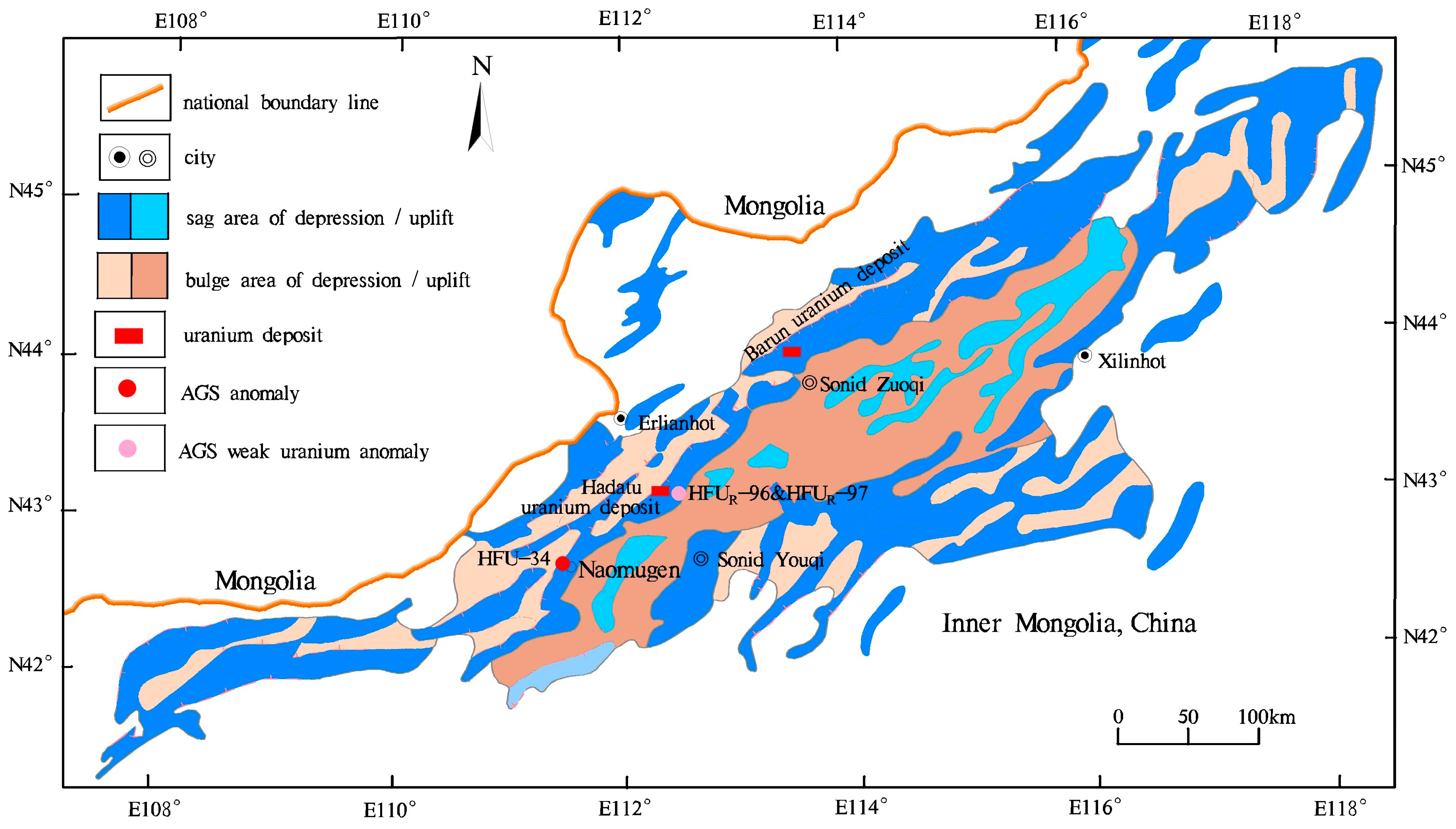

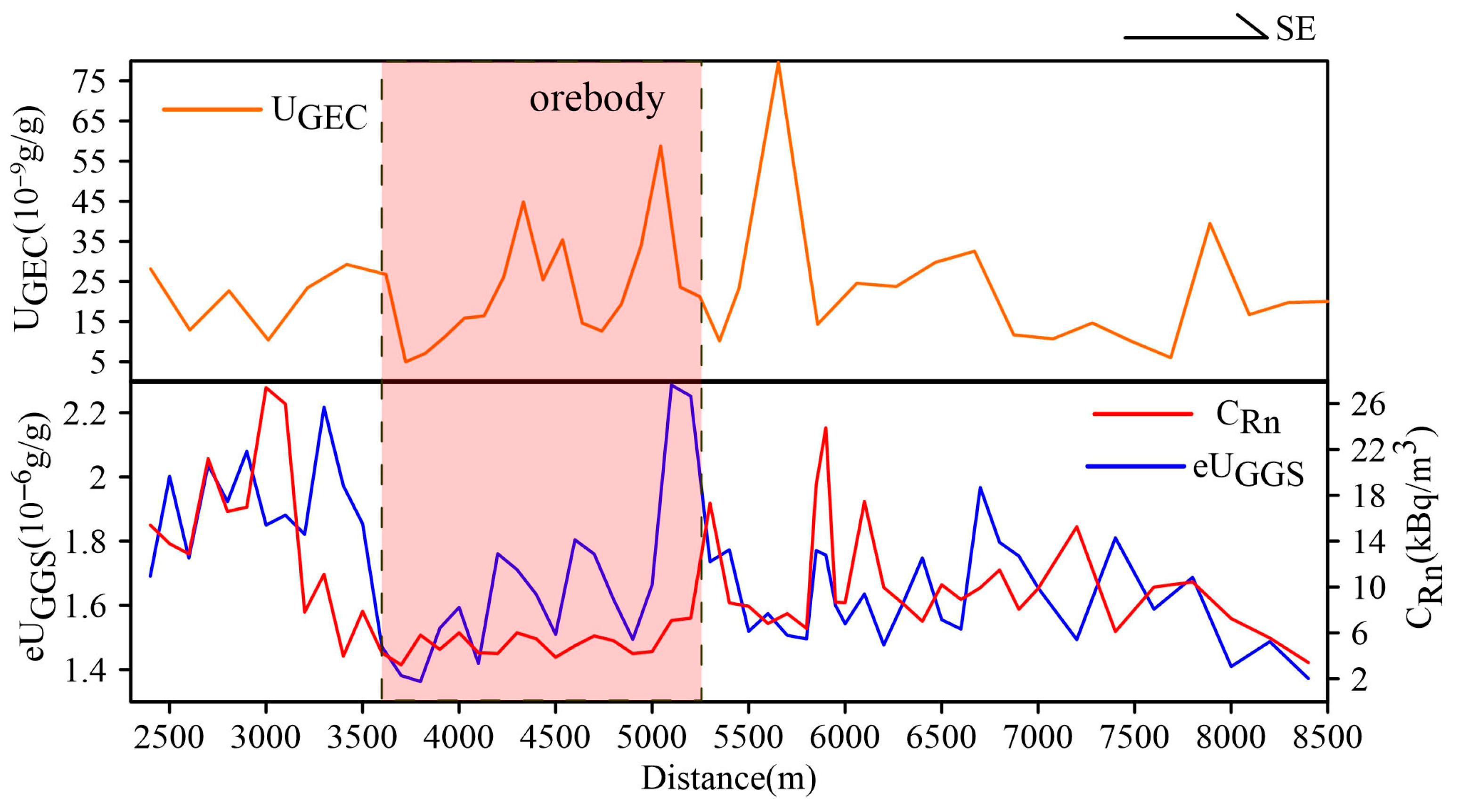

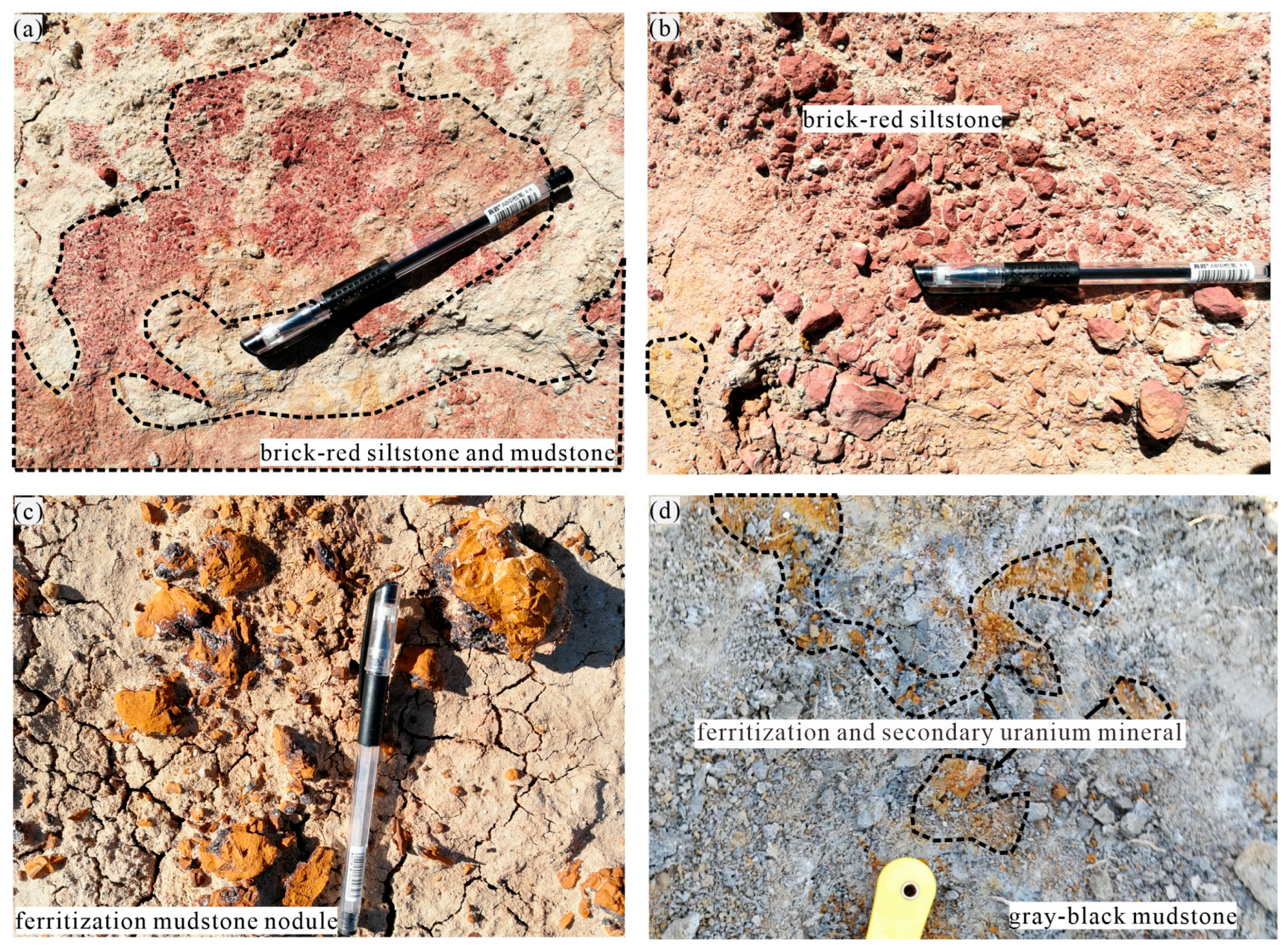
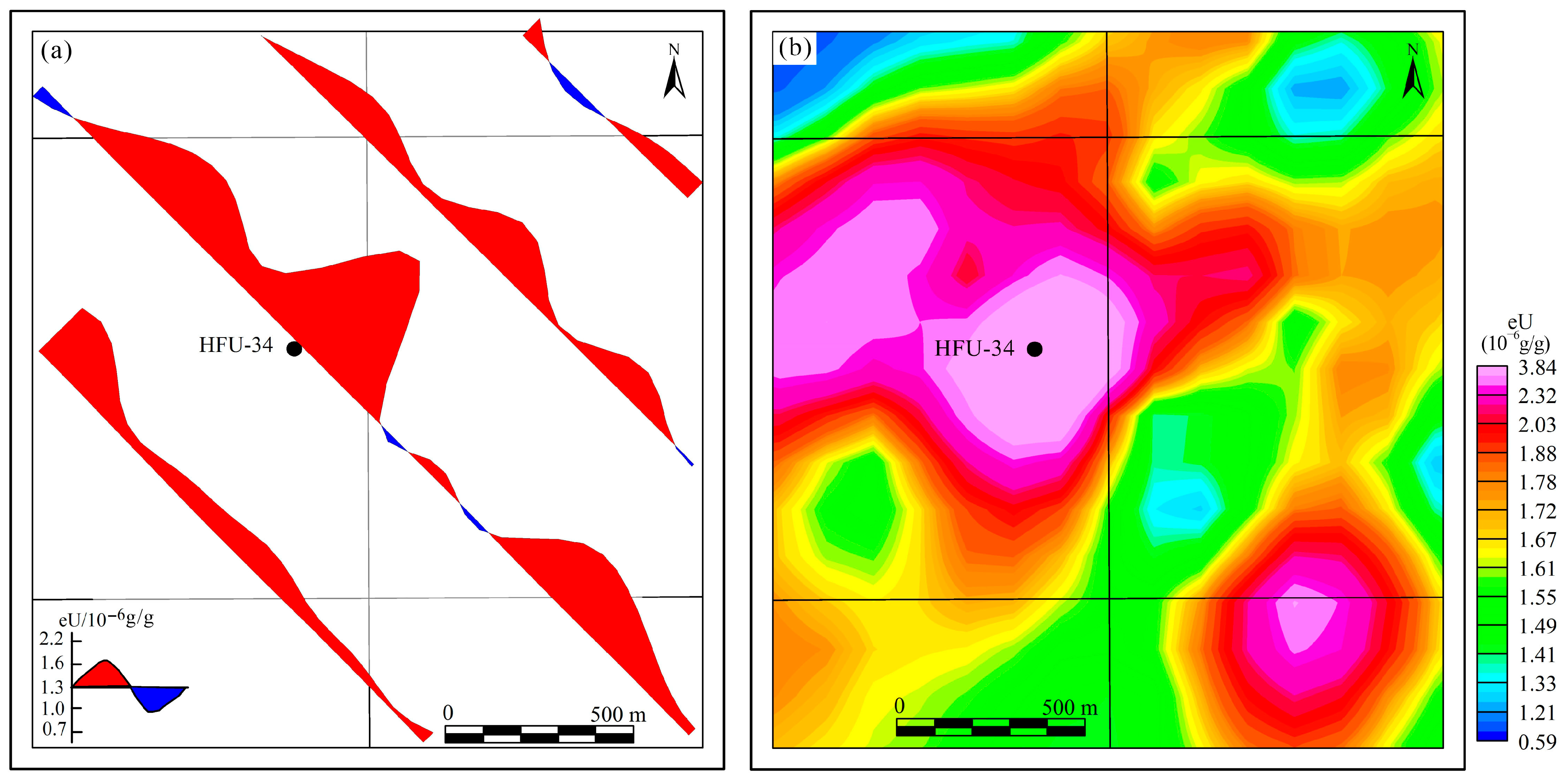
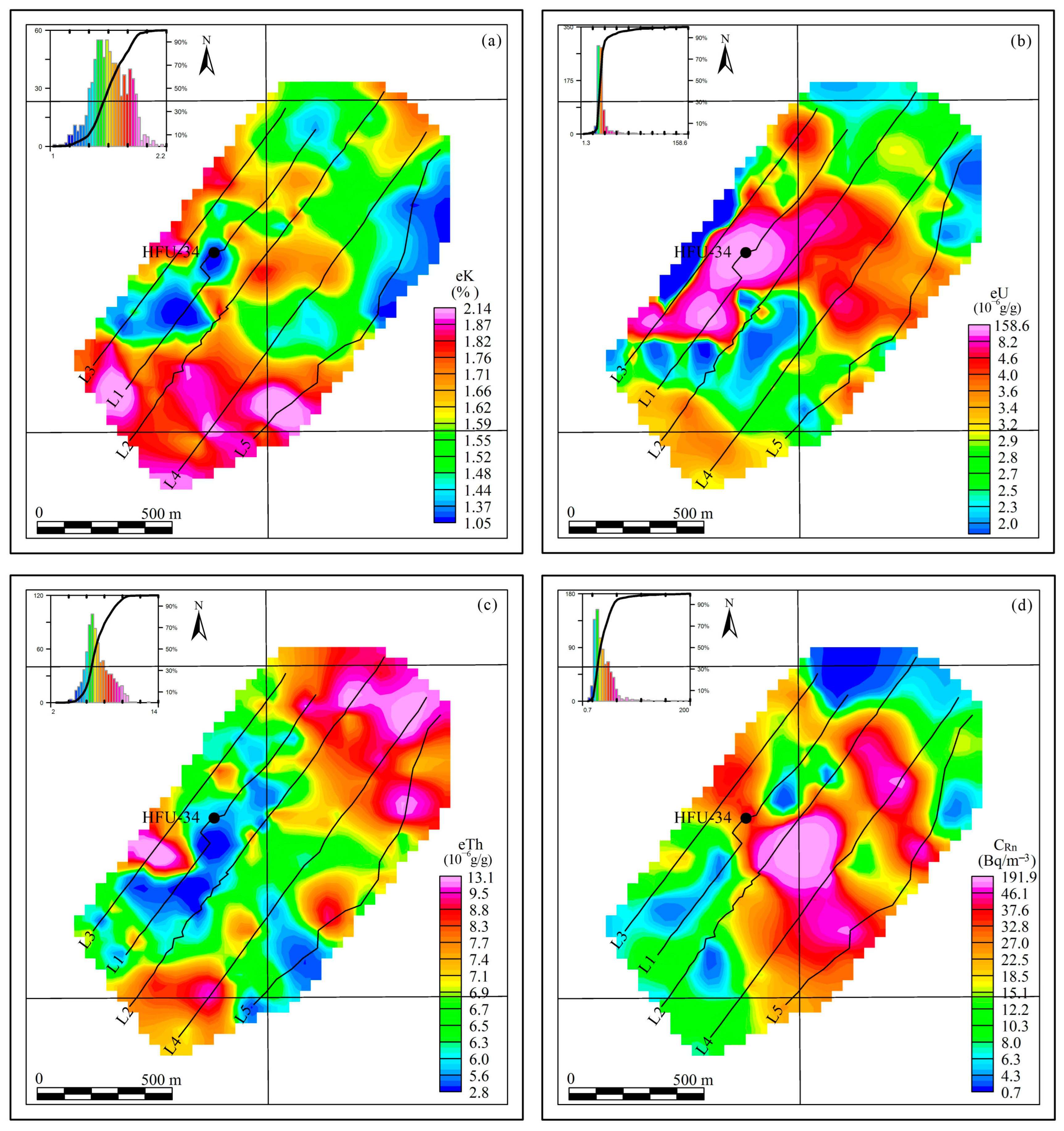
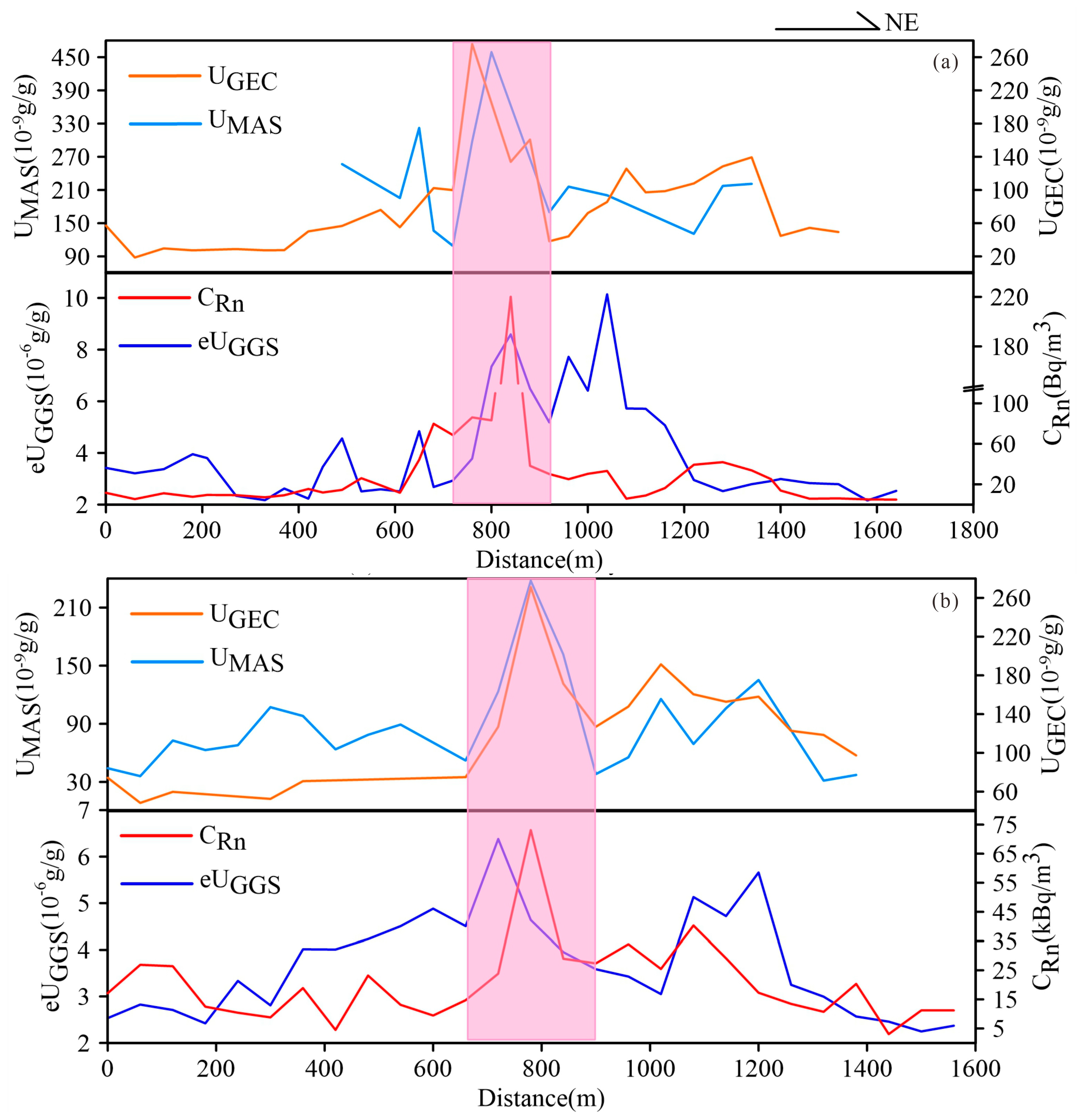
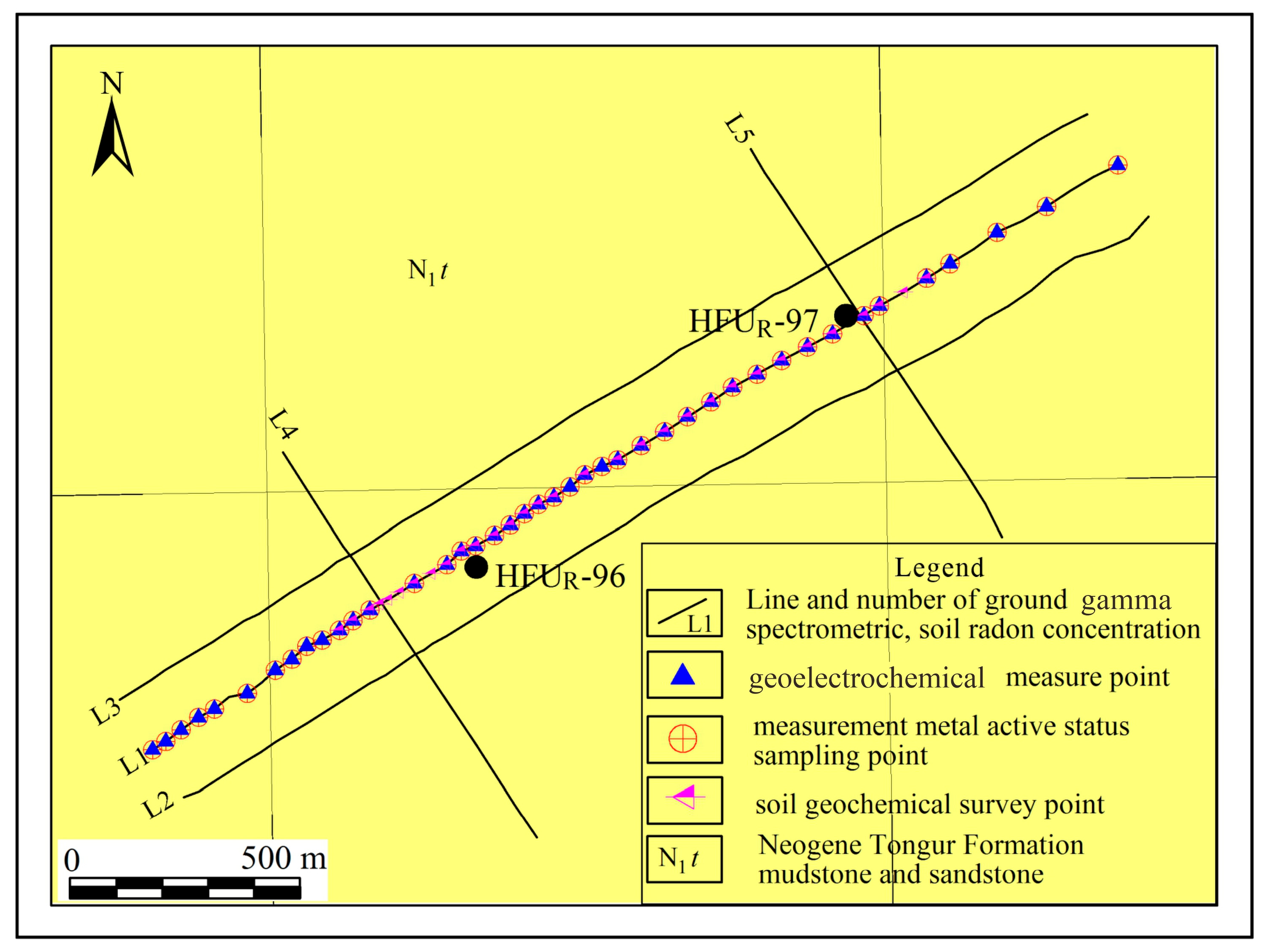
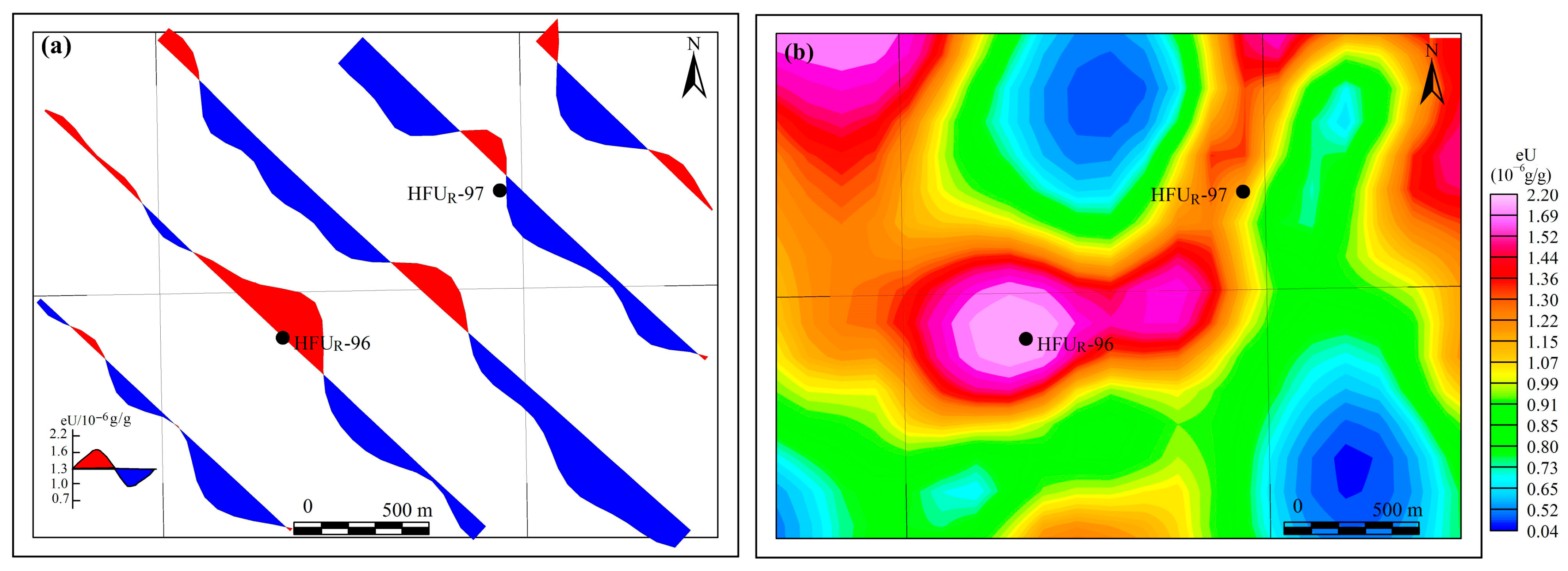
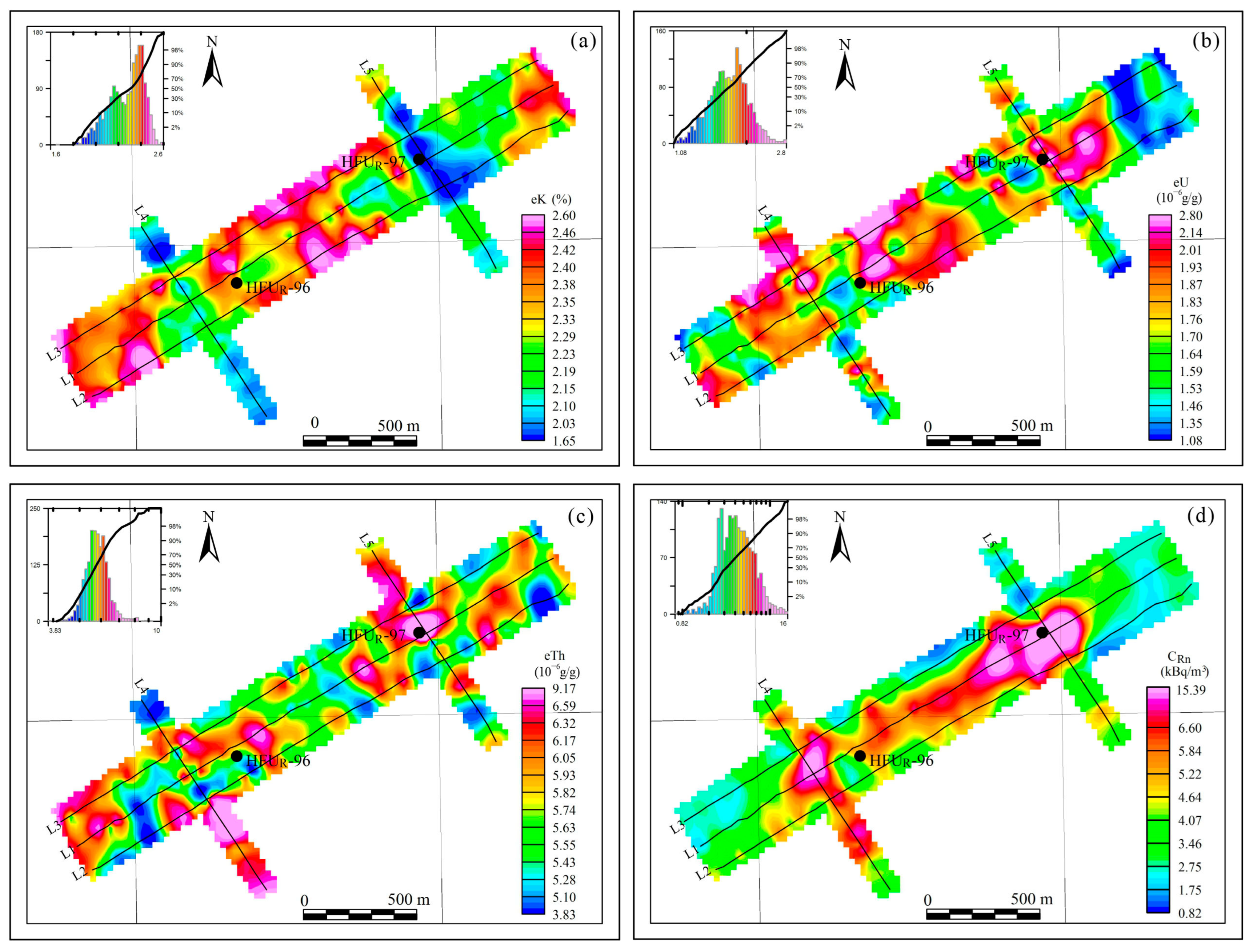

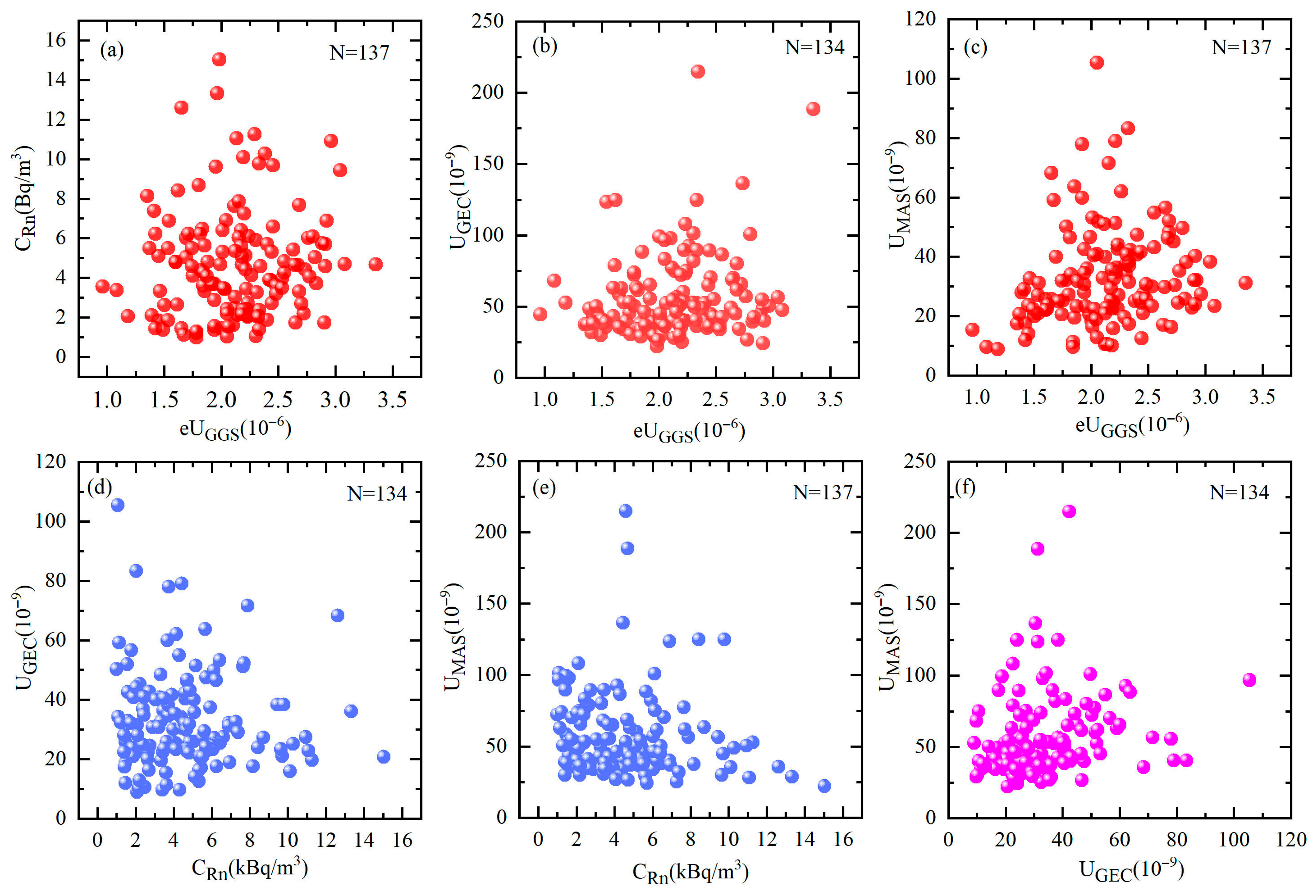

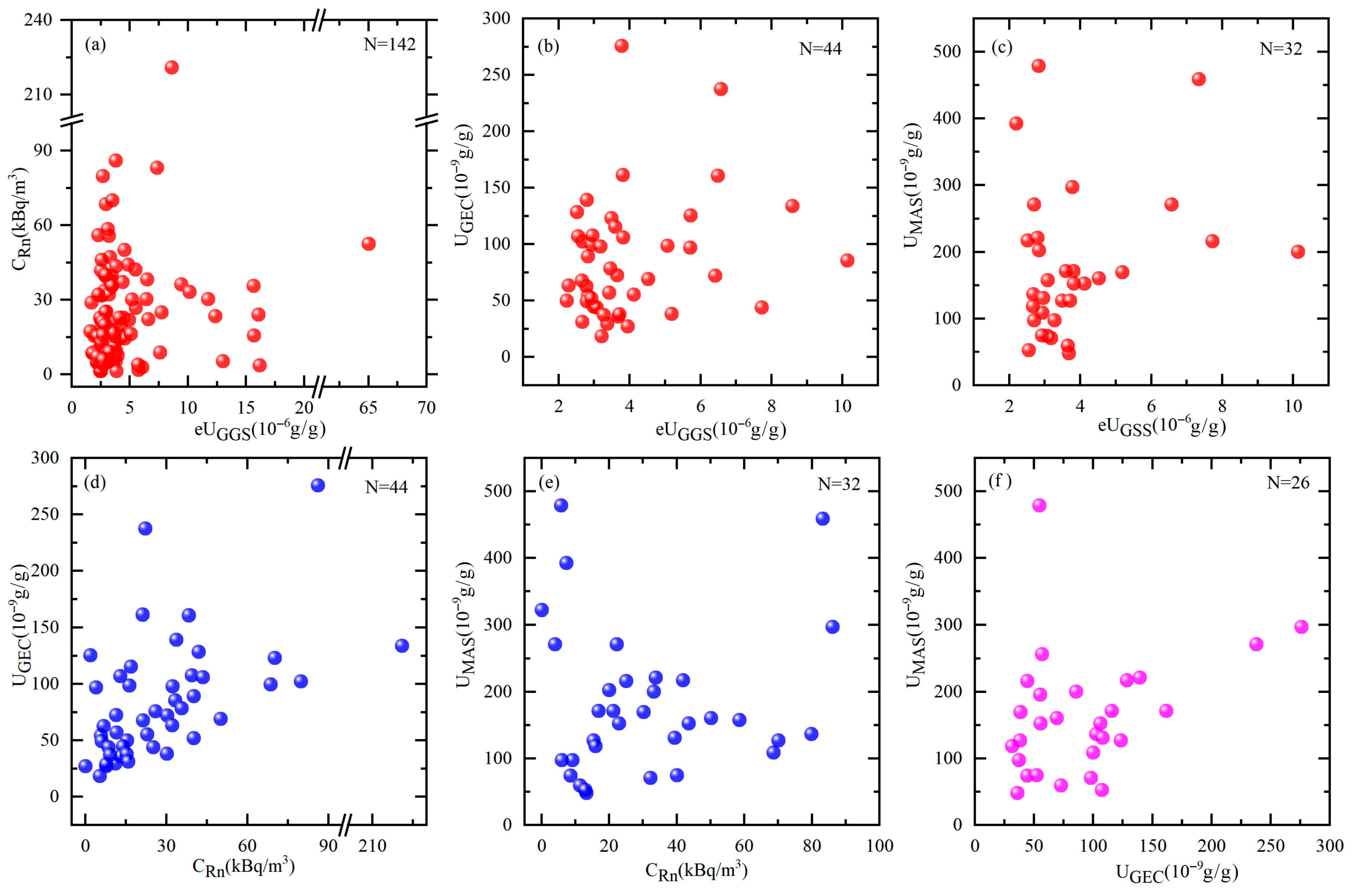
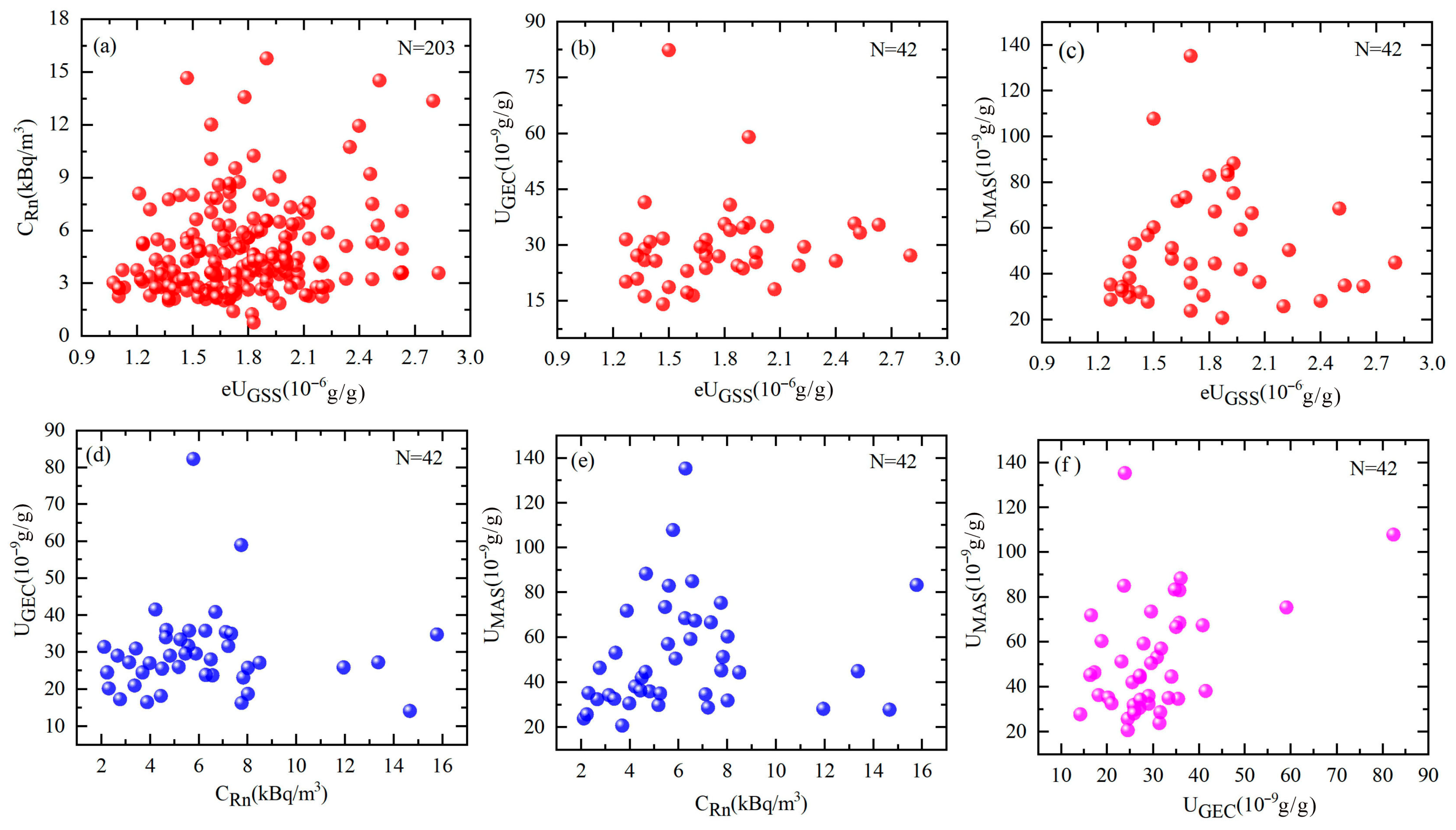
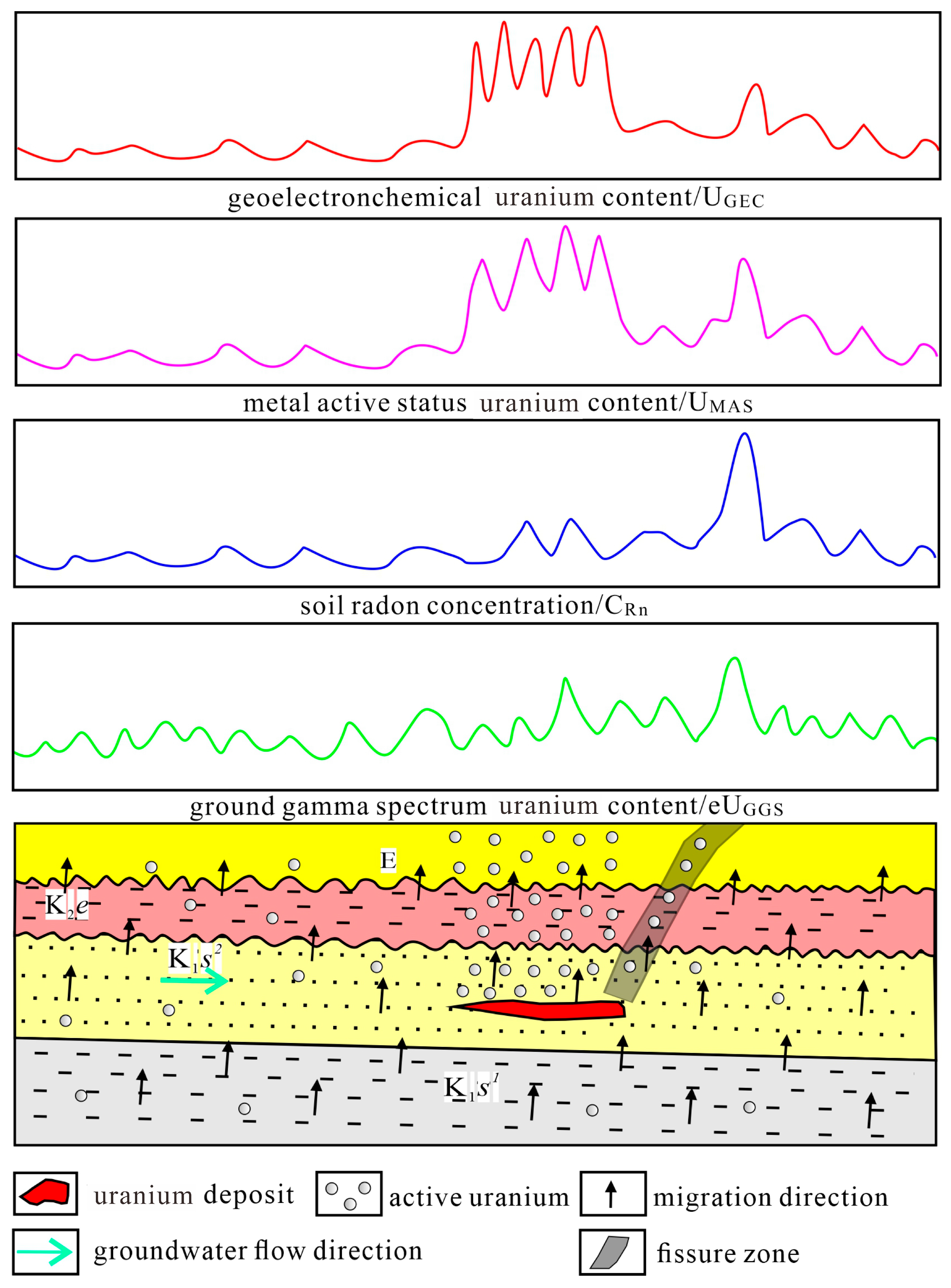
| Statistic | Hadatu Uranium Deposit | Barun Uranium Deposit | |||||
|---|---|---|---|---|---|---|---|
| eUGGS (10−6 g/g) | CRn (kBq/m3) | UGEC (10−9 g/g) | UMAS (10−9 g/g) | eUGGS (10−6 g/g) | CRn (kBq/m3) | UGEC (10−9 g/g) | |
| Numbers | 137 | 137 | 134 | 137 | 273 | 281 | 105 |
| Min value | 0.96 | 1.00 | 3.58 | 22.07 | 0.90 | 2.50 | 5.01 |
| Max value | 3.35 | 15.03 | 105.42 | 215.00 | 2.69 | 91.34 | 134.87 |
| Average | 2.12 | 4.69 | 32.69 | 56.25 | 1.78 | 9.90 | 27.67 |
| Median | 2.13 | 4.39 | 29.63 | 48.52 | 1.75 | 8.23 | 24.58 |
| Standard Deviation | 0.46 | 2.74 | 16.53 | 29.10 | 0.31 | 7.20 | 17.51 |
| Statistic | eUGGS (10−6 g/g) | CRn (kBq/m3) | UGEC (10−6 g/g) | UMAS (10−9 g/g) | Utrace (10−9 g/g) | Ratrace (10−9 g/g) | Kp |
|---|---|---|---|---|---|---|---|
| Numbers | 147 | 148 | 50 | 35 | 22 | 22 | 22 |
| Min value | 1.61 | 1.33 | 18.70 | 48.38 | 4.25 | 14.25 | 0.99 |
| Max value | 158.6 | 220.25 | 275.91 | 478.93 | 1878.16 | 6291.82 | 0.99 |
| Average | 5.23 | 21.27 | 81.24 | 184.72 | 178.84 | 599.11 | 0.99 |
| Median | 3.25 | 15.56 | 48.56 | 97.37 | 28.52 | 95.54 | 0.99 |
| Standard Deviation | 7.42 | 18.34 | 51.84 | 107.28 | 427.66 | 1432.62 | - |
| Parameters | X | S | X + S | X + 2S | X + 3S | 5X |
|---|---|---|---|---|---|---|
| Value | 13.6 | 7.3 | 20.9 | 28.3 | 35.5 | 68 |
| Statistic | eUGGS (10−6 g/g) | CRn (kBq/m3) | UGEC (10−6 g/g) | UMAS (10−9 g/g) | Utrace (10−9 g/g) | Ratrace (10−9 g/g) | Kp |
|---|---|---|---|---|---|---|---|
| Numbers | 204 | 203 | 42 | 42 | 31 | 31 | 31 |
| Min value | 1.07 | 0.78 | 14.12 | 20.72 | 1.35 | 4.76 | 0.79 |
| Max value | 2.83 | 15.77 | 82.38 | 135.34 | 3.87 | 12.14 | 1.16 |
| Average | 1.76 | 4.80 | 29.73 | 51.59 | 2.20 | 7.04 | 0.95 |
| Median | 1.73 | 4.01 | 17.60 | 30.77 | 2.12 | 6.49 | 0.92 |
| Standard Deviation | 0.36 | 2.60 | 11.66 | 24.76 | 0.61 | 1.89 | 0.11 |
| Parameters | X | S | X + S | X + 2S | X + 3S | 5X |
|---|---|---|---|---|---|---|
| Value | 3.31 | 0.77 | 4.08 | 4.85 | 5.61 | 16.56 |
| Hadatu Uranium Deposit | Barun Uranium Deposit | |||||||
|---|---|---|---|---|---|---|---|---|
| eUGGS | CRn | UGEC | UMAS | eUGGS | CRn | UGEC | ||
| eUGGS | 1 | eUGGS | 1 | |||||
| CRn | 0.09 | 1 | CRn | 0.14 | 1 | |||
| UGEC | 0.18 | −0.05 | 1 | UGEC | −0.13 | −0.05 | 1 | |
| UMAS | 0.19 | −0.12 | 0.20 | 1 | ||||
| HFU-34 | HFUR-96 and HFUR-97 | ||||||||
|---|---|---|---|---|---|---|---|---|---|
| eUGGS | CRn | UGEC | UMAS | eUGGS | CRn | UGEC | UMAS | ||
| eUGGS | 1 | eUGGS | 1 | ||||||
| CRn | 0.16 | 1 | CRn | 0.23 | 1 | ||||
| UGEC | 0.23 | 0.41 | 1 | UGEC | 0.10 | 0.01 | 1 | ||
| UMAS | 0.25 | 0.14 | 0.32 | 1 | UMAS | 0.04 | 0.15 | 0.41 | 1 |
Disclaimer/Publisher’s Note: The statements, opinions and data contained in all publications are solely those of the individual author(s) and contributor(s) and not of MDPI and/or the editor(s). MDPI and/or the editor(s) disclaim responsibility for any injury to people or property resulting from any ideas, methods, instructions or products referred to in the content. |
© 2025 by the authors. Licensee MDPI, Basel, Switzerland. This article is an open access article distributed under the terms and conditions of the Creative Commons Attribution (CC BY) license (https://creativecommons.org/licenses/by/4.0/).
Share and Cite
Shi, L.; Li, H.; Wang, N.; Han, P.; Shen, Z.; Yu, C.; Zhang, X.; Meng, X. Methods for Verifying the Relationship Between Weak Uranium Anomaly and Uranium-Rich Geological Bodies in the Covered Areas of the Erlian Basin, Inner Mongolia. Minerals 2025, 15, 1013. https://doi.org/10.3390/min15101013
Shi L, Li H, Wang N, Han P, Shen Z, Yu C, Zhang X, Meng X. Methods for Verifying the Relationship Between Weak Uranium Anomaly and Uranium-Rich Geological Bodies in the Covered Areas of the Erlian Basin, Inner Mongolia. Minerals. 2025; 15(10):1013. https://doi.org/10.3390/min15101013
Chicago/Turabian StyleShi, Liancheng, Huaiyuan Li, Nanping Wang, Penghui Han, Zhengxin Shen, Cong Yu, Xiang Zhang, and Xiangbao Meng. 2025. "Methods for Verifying the Relationship Between Weak Uranium Anomaly and Uranium-Rich Geological Bodies in the Covered Areas of the Erlian Basin, Inner Mongolia" Minerals 15, no. 10: 1013. https://doi.org/10.3390/min15101013
APA StyleShi, L., Li, H., Wang, N., Han, P., Shen, Z., Yu, C., Zhang, X., & Meng, X. (2025). Methods for Verifying the Relationship Between Weak Uranium Anomaly and Uranium-Rich Geological Bodies in the Covered Areas of the Erlian Basin, Inner Mongolia. Minerals, 15(10), 1013. https://doi.org/10.3390/min15101013






